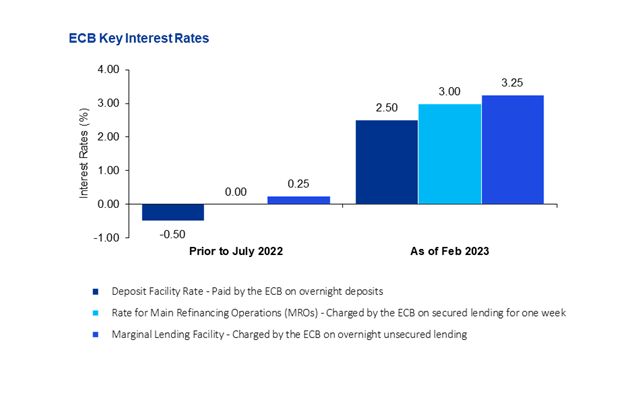ECB Interest Rates
In January 2023, consumer inflation in the Euro area stood at 8.6%1. In Malta, the annual inflation rate stood at 6.8%2. If it weren’t for Government’s decision to keep energy prices fixed, this would invariably be higher.
The European Central Bank (ECB) targets an inflation rate of 2.0% over the medium term to meet its primary function of maintaining price stability across the Euro area. It was therefore no surprise when the ECB decided to increase interest rates and reverse a decade long trend of low or negative interest rates.

Source: ECB data; KPMG analysis
How does increasing interest rates decrease inflation?
The current factors driving up inflation globally are the lingering impact of the pandemic on supply chains, and the ongoing war in Ukraine, which impacted the supply of oil, gas, and grains, explaining the particularly high rates of energy and food inflation.
When interest rates increase, the higher cost of borrowing discourages consumers from buying items usually acquired through bank finance, such as property, cars, and machinery. Higher borrowing costs also leave less money left over to spend on everyday items such as clothing, travelling, and eating out. In turn this decreases the aggregate demand for goods and services, relieving inflationary pressures. Higher interest rates also encourage more saving and consequently less spending.
Loan and deposit interest rates in Malta
The ECB lends funds and accepts deposits from commercial banks in the Euro area, including Malta, as opposed to directly from individuals and businesses. Nonetheless, the interest rates applied by commercial banks generally move in line with ECB rates. However, to date, the increase in ECB rates has seemingly had minor impact on the interest rates offered by local banks.
As per the Central Bank of Malta’s (CBM) latest quarterly review, in September 2022 the average deposit interest rate stood at 0.14%, and the average loan interest rate stood at 3.25%. While there have since been some developments, these have been largely limited to higher deposit interest rates exclusively on new term accounts, the discontinuation of fixed interest rates on new home loan products, and small increases in loan interest margins, and then again, these actions have only been applied by some banks.
Should commercial banks increase rates on overnight deposit accounts – more commonly referred to as savings accounts, and increase their loan base rate, consumers and businesses will be set to experience much bigger differences in their disposable incomes and cash flows.
Why haven’t interest rates in Malta increased yet?
Based on the audited financial statements for year ending 2021, the average loan-to-deposit ratio for core banks3 in Malta stood at 56.6%, while that for significant banks in the Euro area amounted to 104.8%4. This means that generally Maltese banks do not resort to borrowing from the ECB at the current 3.0% MRO rate (Main Refinancing Operations), but rather rely on their own customer deposit base, at the average deposit interest rate of 0.14%, as at September 2022, mentioned earlier, to fund their loan book. In turn, this arrangement allows banks to retain the currently advantageous interest rates on their loan products.
How long will interest rates remain unchanged in Malta?
While the average loan-to-deposit ratio for Maltese core banks stands at 56.6%, the ratio for individual core banks ranged from circa 40.0% to over 90.0%, based on audited financial statements for year ending 2021. The banks with a higher loan-to-deposit ratio will probably be under greater pressure to increase their deposit interest rates so as to maintain, and possibly strengthen, their deposit base.
Once deposit interest rates increase for general savings accounts, banks will very likely increase their base rates in order to safeguard bank profitability.
What happens if banks increase their interest rates on loans?
Locally, home and business loans are generally sanctioned at a fixed margin over a bank’s base rate. Each bank’s base rate is set by the individual bank and may change at any time at that bank’s discretion. On the other hand, the fixed margin specified at sanctioning, cannot be altered for the entirety of the loan’s term.

Let’s take the example of a loan with a bank sanctioned at a fixed margin, of say 1.5% over the bank’s base rate, of say 2.0%, corresponding to a final interest rate of 3.5%. While the fixed margin of 1.5% will remain constant, the 2.0% in the previous example can increase or decrease at the bank’s discretion.
While banks can increase their interest rates exclusively by increasing the margin on new loans, an increase in the banks’ base rates would impact all existing and new loans and overdrafts. Amongst other, an increase in banks’ base rate would be expected to have the following effects on repayments:
New home loans As per current CBM directives5, the repayment-to-income on home loans cannot exceed 40.0% at sanctioning stage and that repayment must be based on a stressed interest rate of 1.5% over the actual final interest rate. Higher interest rates will increase repayments, thus decreasing the maximum amount that customers’ can be sanctioned. As an example, in the event of an increase in interest rate of 1%, a prospective 32-year old customer, with a maximum permissible repayment of €1,000, would see their potential loan amount decrease from roughly €250,000 to €220,0006.
Existing home loans Increases in interest rates will result in higher monthly repayments. The amount by which a customer’s loan repayment will increase will depend on the outstanding balance of the loan and the remaining term. As an indication, an increase of 1.0% in the base rate on a loan with an outstanding capital of €100,000 and a remaining term of 20 years, would imply an increase in repayment of circa €50 per month, over the term of the loan7.
Personal loans Similarly to home loans, increases in interest rates will impact the amount that can be sanctioned and increase the monthly repayments. However, the CBM does not stipulate a maximum repayment-to-income for personal loans.
Business loans Increases in interest rates will be reflected in higher loan repayments impacting the cash flow of the business. Unlike home loans, repayment amounts on business loans are not subject to a maximum by the CBM. For instance, if interest rates were to increase by 1%, a business loan of €500,000 with a term of 10 years, would incur an increase in repayment of circa €240 monthly over the term of the loan8.
Overdrafts Interest rates on overdraft is charged periodically and there is no fixed monthly repayment with respect to the outstanding balance. Therefore, increases in interest rates will increase the interest due accordingly.
In summary…
If, when, and how to increase interest rates, will probably be the single most important decision for local banks this financial year. What each bank decides will be influenced by their current position in the market and will necessitate a fine balancing act between the interests of their net deposit customers, their net borrowing customers, and their shareholders.
On a reassuring note, the Maltese banking sector has undergone significant expansion over the past two decades and today’s banks are heterogenous and cater for different markets – banks vary both in terms of balance sheet characteristics, as well as market objectives. Thus, it is unlikely that all banks will increase interest rates in unison, allowing customers to make the best choices depending on their own personal realities.
The information contained herein is of a general nature and is not intended to address the circumstances of any particular individual or entity. Although we endeavor to provide accurate and timely information, there can be no guarantee that such information is accurate as of the date it is received or that it will continue to be accurate in the future. No one should act on such information without appropriate professional advice after a thorough examination of the particular situation.
1 Eurostat
2 National Statistics Office – Harmonised Index of Consumer Prices (HICP): January 2023 030/2023
3The Central Bank of Malta classifies APS, BNF, BOV, HSBC, Lombard, and MeDirect Bank (Malta) as core domestic banks.
4European Central Bank - Supervisory Banking Statistics, Third Quarter 2022
5Central Bank of Malta – Directive no 16
6Based on an increase in the loan interest rate from 2.94% to 3.94%, 2.94% being the average loan interest rate for households as at September 2022 (CBM Quarterly Review 2023:1)
7As above
8Based on an increase in the loan interest rate from 3.82% to 4.82%, 3.82% being the average loan interest rate for non-financial-corporations as at September 2022 (CBM Quarterly Review 2023:1)


